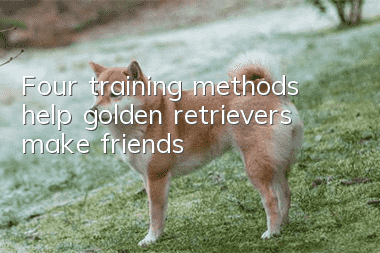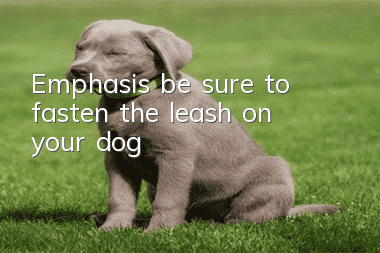Four training methods help golden retrievers make friends

Every dog mother hopes that her dog will be more well-behaved, sensible, and obedient, especially when she sees other people’s dogs being obedient and listening to their owners’ instructions, but being active, naughty, and hee-hee is what everyone wants. The nature of dogs, so how to better train your dogs? There are actually skills and methods for this!
1. Playing with children
Step 1: When a child throws a retrieval toy, the dog will become very alert. A well-trained dog will only do what he is told to do. It is best to let adults do the game training of retrieving objects. Only involve children if the dog knows exactly what to do.
Step 2: Children accept the toys retrieved by the dog under adult supervision. Until a child becomes a child, and until he understands how to play with a dog and is able to control the dog, all activities with dogs should be conducted under adult supervision.
Step 3: When the child holds the toy, he can reward the dog with food. By playing games, your dog will learn that children have rights in the human community he lives in. It will also learn to be fun to play with children.
2. Do not chase or bite other animals
The first step: The training method is that unless your dog has lived with other animals since he was a child, you should estimate the problems when he encounters livestock. The dog first stared at the sheep, but it was under the control of its owner on a leash. Don't let your dog run off the leash on a farm (or anywhere else with animals) unless you're sure it won't chase other animals. You should take similar precautions when your dog encounters other animals for the first time.
Step 2: The purpose of this exercise is to transform your dog’s chasing instinct into controlled movement. Experiment with different toys to find out which toy your dog likes best. Amuse your dog with toys.
Step 3: The training location should be quiet so that it is not easy to distract. It is best to be outdoors. Control the dog with a long rope and throw out the toy it likes, but put another toy it likes next to you. . It will instinctively chase thrown toys.
Step 4: Before the dog touches the toy, call its name and order it to "come here." Be more dramatic when calling your dog back, and wave the second toy to lure him back. Then play with your dog and reward him.
Step 5: Go to the toy, pick it up, and use the leash to bring it back. Your dog will know that the toy it is chasing belongs to you. Repeat steps three through five in a more stimulating environment.
3. Do not provoke other dogs
The first step: The training method is eye contact. You should make eye contact when your dog makes eye contact with the opponent.interference. A raised tail and a glare will indicate that a fight is about to break out.
Step 2: Intense challenge. Dogs with aggressive behavior caused by total dominance are difficult to handle. In most cases, fights are preceded by aggressive body postures and yelling. Unless one of the dogs backs down, a fight is inevitable. During a fight, the dog may bite anyone who interferes—including the owner.
Step 3: Between you and other dogs, many dogs will use aggressive behavior to protect their owners. Your dog standing between you and other dogs, tugging on the leash, will reinforce his aggression. The dog may eventually associate the feeling of a tight leash with aggression, whereas the aggressive behavior may not occur if the leash is disconnected.
Step 4: Tight Leash Syndrome Although you may instinctively shorten the leash when your dog is acting aggressively, this will generally exacerbate the behavior. Forcibly pulling it back will increase its desire to attack. You should turn his head away so that he cannot make eye contact with other dogs.
Step 5: Distract the dog's attention. When you encounter possible aggressive behavior, you should use a toy that the dog likes to attract its attention, and then order it to "sit". You should reward your dog when he behaves well.
Step 6: Carry out recall training. Carry out this recall training in a quiet, interference-free environment, preferably outdoors. Retrain your dog to come back to you using a long leash or leash while coaxing him in with a toy he likes.
4. Behavior modification of timid dogs
The first step: "Desensitization training" is to reduce the dog's sensitivity to the things it is afraid of. Here we take "the sound that dogs are afraid of" as an example to propose training methods. Dog owners can use this principle to train whatever their dog is afraid of. The training method is: ask the dog owner to use a tape recorder to record the sounds that scare the dog.
Step 2: Play it while the dog is eating. At first, play it quietly and farther away from the dog. The distance and volume should be adjusted based on the principle that the dog can tolerate it and eat (the dog does not eat, which means the stimulation is too great). .
Step 3: Slowly close the distance and increase the volume, but still based on the principle that the dog can eat.
- golden retriever genetic disease
- How to train the ferocity of a Rottweiler? How to train a Rottweiler!
- Prevention and care of dog diseases
- The fastest way to treat eczema in dogs
- Symptoms of dog poisoning
- What are the consequences of dogs drinking beer?
- How to train a Pomeranian to shake hands? Pomeranian life training guide!
- Dogs always like to be close to people. What should I do if they are too clingy to their owners?
- Causes of ovarian cysts in dogs | Diagnosis | Prevention and treatment methods
- Signs of fatal disease in dogs



